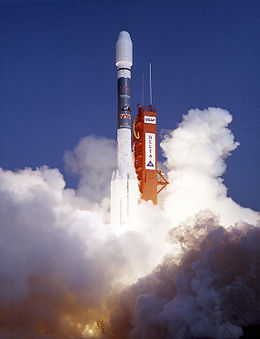 Launch of the ROSAT in Cape Canaveral, Florida. | |
| Names | ROSAT |
|---|---|
| Mission type | Space Telescope |
| Operator | DLR / NASA |
| COSPAR ID | 1990-049A |
| SATCAT no. | 20638 |
| Website | www |
| Mission duration | 8 years and 8 months |
| Spacecraft properties | |
| Launch mass | 2,421 kilograms (5,337 lb) |
| Start of mission | |
| Launch date | 21:48:00, 1 June 1990 (UTC) |
| Rocket | Delta II 6920-10 |
| Launch site | Cape Canaveral LC-17A |
| End of mission | |
| Deactivated | 12 February 1999 |
| Decay date | 23:00:00, 23 October 2011 (UTC) |
| Orbital parameters | |
| Reference system | Geocentric |
| Eccentricity | 0 |
| Perigee altitude | 580 km (360 mi)[1] |
| Apogee altitude | 580 km (360 mi) |
| Inclination | 53° |
| Period | 96 min |
| Epoch | 1990-06-01 |
| Main | |
| Type | Wolter I |
| Diameter | 84 centimetres (33 in) |
| Focal length | 240 centimetres (94 in) |
| Wavelengths | 30-0.06 nm, X-rays and Extreme Ultraviolet |
| Resolution | 5 arc-s at half energy width[1] |
| Instruments | |
| Position Sensitive Proportional Counter Wide Field Camera High Resolution Imager | |
ROSAT (short for Röntgensatellit; in German X-rays are called Röntgenstrahlen, in honour of Wilhelm Röntgen) was a German Aerospace Center-led satellite X-ray telescope, with instruments built by West Germany, the United Kingdom and the United States. It was launched on 1 June 1990, on a Delta II rocket from Cape Canaveral, on what was initially designed as an 18-month mission, with provision for up to five years of operation. ROSAT operated for over eight years, finally shutting down on 12 February 1999.
In February 2011, it was reported that the 2,400 kg (5,291 lb) satellite was unlikely to burn up entirely while re-entering the Earth's atmosphere due to the large amount of ceramics and glass used in construction. Parts as heavy as 400 kg (882 lb) could impact the surface.[2] ROSAT eventually re-entered the Earth's atmosphere on 23 October 2011 over the Bay of Bengal.[3]
- ^ a b "ROSAT space craft details". nssdc.gsfc.nasa.gov. NASA. Retrieved 23 April 2016.
- ^ Seidler, Christoph (26 February 2011). "Drohender Absturz: Problem-Satellit beunruhigt Bundesregierung". Der Spiegel (in German). Retrieved 26 February 2011.
- ^ DLR. "ROSAT re-entered atmosphere over Bay of Bengal". DLR Portal. Retrieved 14 July 2018.